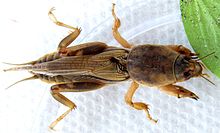Neoscapteriscus vicinus
| Tawny mole cricket | |
|---|---|
 |
|
| Neoscapteriscus vicinus | |
| Scientific classification | |
| Kingdom: | Animalia |
| Phylum: | Arthropoda |
| Class: | Insecta |
| Order: | Orthoptera |
| Suborder: | Ensifera |
| Family: | Gryllotalpidae |
| Genus: | Neoscapteriscus Castena-Castañeda 2015 |
| Species: | N. vicinus |
| Binomial name | |
|
Neoscapteriscus vicinus (Scudder, 1869) |
|
| Synonyms | |
|
|
Neoscapteriscus vicinus, the tawny mole cricket, is a species of insect in the mole cricket family, Gryllotalpidae. Colombian insect taxonomist Oscar Cadena-Castañeda studied specimens of the genus that had been called Scapteriscus, and decided that it included 2 groups (1) a smaller group (the true Scapteriscus) and a larger group that he named Neoscapteriscus (a new genus)in 2015 . It is native to South America and also occurs in the southern United States where it arrived as a contaminant of ship's ballast around 1900. North American mole cricket taxonomists agreed with his decision and altered Orthoptera Species File Online accordingly.
Neoscapteriscus vicinus is a medium-sized mole cricket. Members of this genus are characterized by having two sharp claws and a blade-like process with a sharp edge on their forelegs. Other mole crickets have three or four claws. Its colour is yellowish-brown with a dark prothorax. It can be told from the rather similar Neoscapteriscus borellii by the fact that the two claws are almost touching at the base, whereas in N. borellii, they are widely separated. The song of N.vicinus, produced only by the males, is a loud trill with a pulse rate of 130 per second.
Neoscapteriscus vicinus is native to South America. Since arriving in the United States, it has increased its range, which now extends from North Carolina to Louisiana and the whole of Florida, and west to Texas. Though thought of primarily as a pest of turf and grassland, it also damages many crop plants including tomatoes, strawberries, vegetables, peanuts, sugar cane, tobacco and ornamental plants.
Neoscapteriscus vicinus burrows in sandy soil creating galleries, usually in the upper 25 cm (10 in), the depth depending on the temperature and soil moisture content. In Florida the adults are active in spring and again in autumn, completing a single life cycle during the summer months and overwintering as a large nymph. N. vicinus is herbivorous and feeds on the roots and young shoots of plants, and also causes damage to plants through its burrowing activities. Breeding takes place in spring and autumn, with the male calling soon after sunset to attract a female. After copulation the female lays between 25 and 60 eggs in an underground chamber, the entrance to which is then blocked with soil. The eggs hatch some three weeks later. The nymphs take several months to develop fully, passing through eight to ten moults.
In an attempt to reduce the damage done by Neocapteriscus mole crickets in Florida, biological pest control has been attempted using natural enemies introduced from South America. It was considered to have been achieved by 2004, at which time the program at the University of Florida was shut down. In 2006 a summary publication announced success: a 95% reduction in mole cricket numbers in northern Florida, with biological control agents spreading potentially to all parts of Florida.. Larra bicolor is a parasitoid wasp which deposits eggs on adult mole crickets . The fly Ormia depleta acts in a similar manner, laying eggs on them in both cases, the developing larvae devour the tissues of the host. The mole cricket nematode (Steinernema scapterisci) liberates a bacterium which causes sepsis and death to its host mole cricket.
...
Wikipedia
